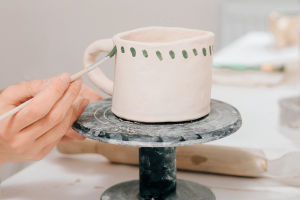Clay Meets Creativity
When you pick up a handmade ceramic mug or admire a decorative pottery vase, have you ever wondered—where does functionality end and art begin? Ceramics is a unique artistic discipline where these two ideas aren't separated but seamlessly integrated.
From ancient vessels designed to hold water to contemporary sculptural pieces showcased in galleries, ceramics continue to balance practicality with aesthetic purpose. Let's explore how ceramic art has evolved and why it remains one of the most versatile and expressive forms of creative work today.
Ancient Roots of Ceramic Functionality
Ceramics have been part of human civilization for more than 10,000 years. Archaeological finds from Mesopotamia include ceramic bowls, pots and storage jars – each carefully crafted to meet daily needs. These items were functional, yes, but also often decorated with intricate patterns, glazes, and symbolic carvings. The early potter wasn't just a craftsperson but also an artist, blending utility with storytelling and cultural expression.
From Utility to Art Form
In many cultures, ceramic work evolved into an art form while still maintaining its practical purpose. Japanese tea bowls used in the traditional tea ceremony, for example, are prized not just for their utility but for their subtle elegance and wabi-sabi aesthetics.
Similarly, Pre-Columbian Moche Pottery from Peru – molded into expressive portrait vessels and ritualistic forms, was used for food, drink, and funerary offerings, often depicting deities, animals, and routine scenes that reveal the Moche civilization’s mythology and daily life.
This dual purpose—serving and beautifying—has remained a defining feature of ceramics through the centuries.
The Studio Pottery Movement
In the 20th century, the line between fine art and functional ceramics blurred even further. The studio pottery movement, especially in Western countries, emphasized handmade, small-batch ceramics that prioritized both visual beauty and everyday use.
Artists like Bernard Leach and Shoji Hamada championed the philosophy that a simple bowl could be just as expressive as a canvas painting. Their work encouraged a deeper appreciation for the tactile qualities of clay—texture, weight, glaze—and how these elements could evoke emotional or aesthetic responses.
Modern Ceramics: A Canvas for Innovation
Today, contemporary ceramicists are pushing the boundaries even further. Some use experimental glazes and firing techniques to create unpredictable surface effects, while others blend ceramics with other media like metal or glass. Artists like Grayson Perry and Betty Woodman have brought ceramics into the realm of conceptual art, using functional forms to comment on identity, history, and society. The result is a field where mugs, bowls, and tiles might serve tea—or serve as political commentary.
Why Function Still Matters
While modern art often emphasizes concept over form, ceramics retains a strong connection to function. The experience of using a beautifully made ceramic piece can transform everyday activities—drinking coffee, serving food, or arranging flowers—into moments of sensory enjoyment.
The weight of the cup, the curve of the handle, the feel of the glaze—all contribute to an experience that's deeply personal and grounded in touch. Many collectors and users seek out handmade ceramics precisely for this reason: it brings art into daily life in a practical and human way.
The Role of Material and Technique
One reason ceramics can be both useful and beautiful is the nature of the material itself. Clay is versatile—it can be thrown on a wheel, molded by hand, or pressed into molds. It can be smooth or rough, glazed or matte, sturdy or fragile. Firing techniques, like raku, reduction, or high-temperature kiln firing, offer endless possibilities for surface texture and color. Each of these choices reflects the artist's intention and affects how the final object functions in the real world.
Cross-Cultural Inspirations
Ceramics is a global art form, and today's artists often draw from a range of cultural traditions. Korean celadon, Persian tile work, Mexican Talavera, and Moroccan ceramics all offer unique approaches to color, pattern, and form. This cross-pollination of styles creates fresh interpretations that merge function with design. For example, a plate inspired by Japanese minimalism might be paired with a Moroccan color palette, blending traditions into something entirely new.
Educational and Therapeutic Value
Beyond aesthetics and function, working with ceramics also has emotional and psychological benefits. According to research published in Arts & Health in 2014, engaging in ceramic creation can reduce anxiety and promote mindfulness. The hands-on nature of the craft encourages focus, patience, and a sense of control. Many schools and therapy programs now incorporate ceramics as a tool for learning, rehabilitation, and self-expression.
Conclusion: A Living Art for Everyday Life
Ceramics is not just an art for galleries or museums. It lives on kitchen shelves, in garden pots, on dining tables. It is touched, used, and appreciated every day. That's what makes it so special—the ability to unite the practical with the poetic. As you sip from your favorite handmade cup or admire a ceramic tile mural in a city square, you're experiencing art in one of its most accessible and enduring forms.
Have you ever tried working with clay—or do you have a favorite handmade ceramic object at home? What do you value more: how it looks or how it feels in your hand? Share your thoughts and join the conversation about this timeless blend of craft and creativity!
-
 Clay Meets CreativityHow Ceramics Beautifully Blend Functionality with Artistic Expression
Clay Meets CreativityHow Ceramics Beautifully Blend Functionality with Artistic Expression -
 Soundtracks That SpeakSoundtracks That Speak: How Music in Art Films Influences Emotion and Thought Without a Word
Soundtracks That SpeakSoundtracks That Speak: How Music in Art Films Influences Emotion and Thought Without a Word -
 Urban Art, Timeless VoicesWhat if every wall held a voice? Dive into street art’s powerful past—where bold colors whisper untold truths.
Urban Art, Timeless VoicesWhat if every wall held a voice? Dive into street art’s powerful past—where bold colors whisper untold truths.
Copyright © zogu 2021 - 2025. All Right Reserved.